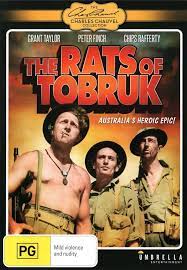
THE RATS OF TOBRUK
Australia, 1944, 96 minutes, Black-and-white.
Grant Taylor, Peter Finch, Chips Rafferty, George Wallace, Joe Valli.
Directed by Charles Chauvel.
Australia made very few feature films during World War II. There had been quite some activity, especially with director, Ken Hall during the 1930s but from 1939, resources were poured into the war effort.
Veteran husband and wife team, Charles and Elsa Chauvel, had moved into filmmaking in the 1920s. During the 1930s they tackled historical themes and First Nations themes in Heritage and Uncivilised. However, they were able to make a feature film, supporting the war effort, going back to the exploits of World War I, the lighthorsemen and the charge of the Sheba, the film 40,000 Horsemen.
The Chauvels researched the deploying of Australian troops in North Africa, the fight against Erwin Rommel and his advances through the desert, the Australians being settled in the Libyan town of Tobruk, besieged for many months, digging in, literally, and dismissed by the British broadcaster from Berlin, Lord Haw Haw, as rats. However, the nickname was taken as a badge of honour and the Australians in Tobruk have always been remembered as the Rats off Tobruk.
After preparing the screenplay and making it authentic, companies and the government provided the support for the filmmaking, desert scenes on the beach of Cronulla, Tobruk scenes built at Camden, and the final PNG sequences in Queensland.
Grant Taylor and Chips Rafferty had appeared in 40,000 Horsemen and were joined here by Peter Finch, British but growing up in Australia, appearing in radio drama and some films. Included in the cast were to comedians of the period, George Wallace who had appeared in his own films, very broad slapstick humour, and Joe Valli, with some eccentric humorous sequences.
A seriously abridged version, 68 minutes, was released in the US in the early 1950s and dismissed. The story was taken up by Hollywood in a sequel to film about Rommel, The Desert Fox with James Mason, The Desert Rats.
The film illustrates the Australian outback and stockman in the opening sequences (seen to advantage in 1946 with Chips Rafferty in The Overlanders), some touches of romance with Australian male reticence, a lot of mateship during the war, not underestimating the wounded and dead, and a continuation of the war during the film’s release in 1944 in Papua New Guinea.
- The impact of this film in 1944, World War II, the memory of Australian action in North Africa, the siege of Tobruk? Heroism, the blocking to the blitzkrieg Nazi attack, stopping Rommel? In the aftermath of the soldiers transferring to the war in New Guinea?
- The impact of the film decades later, a record of the events, a tribute, lest we forget, a portrait of Australian men at the time, Australian humour, vernacular? And changes since?
- The work of Charles and Elsa Chauvel, perspectives on Australian history? 40,000 Horsemen in World War I? For the war effort? This film and the war effort, an Australian production collaboration in a time when there was little Australian film production?
- The opening, the atmosphere of the stockmen, out with the cattle, the vast distances, the movement, the different terrains, passing through properties?
- The focus on Bluey, his leadership, on Peter from England and his observations, writing, taking notes, on Milo as the stockman, cheery, recognisable Australian image? Their friendships, the work?
- Bluey and the meeting with Kate, her expectations, the Australian male reserve, attracted, manner of speaking, the touch of detachment, her response? Peter and his observing the relationship, later the letters, writing letters, fostering the relationship with Bluey? And the romantic ending, Bluey and the war experiences, the effect on him, his return, Kate waiting for him? The marriage?
- News of the outbreak of the war, enlisting, the three finding themselves in Africa?
- The Australian locations for Libya, Tobruk, the desert, the Sydney Beaches, the Tobruk headquarters, Queensland locations for new Guinea?
- The situation in Africa, the attack of the Germans, defeating the British, the Allies? The role of the Australians, in Tobruk, the siege, over six months, the Australians holding, the impact of the battle sequences, the German advance, the defence, the strategy with the tanks, letting them through, capturing them? The prisoners of war?
- The situation in Tobruk, digging and the underground, the attacks, deaths, wounding, the military hospital, Peter being wounded, in the hospital, the encounter with Mary, the nurse, her being evacuated, correspondence, and the later bar sequence and the singing the song, Mary? The range of wounded men, Milo, rescuing Bluey, the head wound, in the hospital? The camaraderie amongst the men?
- Moving around Tobruk, the buildings, shops, souvenirs, the bar? The ordinariness?
- The comedy and the film, George Wallace, his screen persona, broad comedy, the barber, at work, wanting a transfer to Greece, friendship with the trio, the sequence of the officer falling asleep, George’s concern about him? The impact of the humour today, of its time?
- The comedy in the film and Joe Valli, Scotsman, the dialogue, imagining the birds, chasing them, his reappearing in the barbershop, the attempted shape, finding the birds?
- The role of the Rats of Tobruk, Lord Haw Haw and his broadcasts from Berlin, ridiculing the Australians and their style, calling them rats, and this becoming distinctive for them?
- The final time in North Africa, the fighting, Peter and his being wounded, the men gathering round him, his death? Leaving his manuscript?
- The sudden shock of Milo’s death?
- The return to Australia, the tickertape parade through the city? The commentary about the heroism? And listening
- Transition to the war in New Guinea, the Japanese, the jungle in the mud, the Japanese on the rockets, Bluey and the combat fight with the Japanese, his being rescued by the “Fuzzy Wuzzy” Angels”? The war continuing?
- And the happy finale with Bluey and Kate?